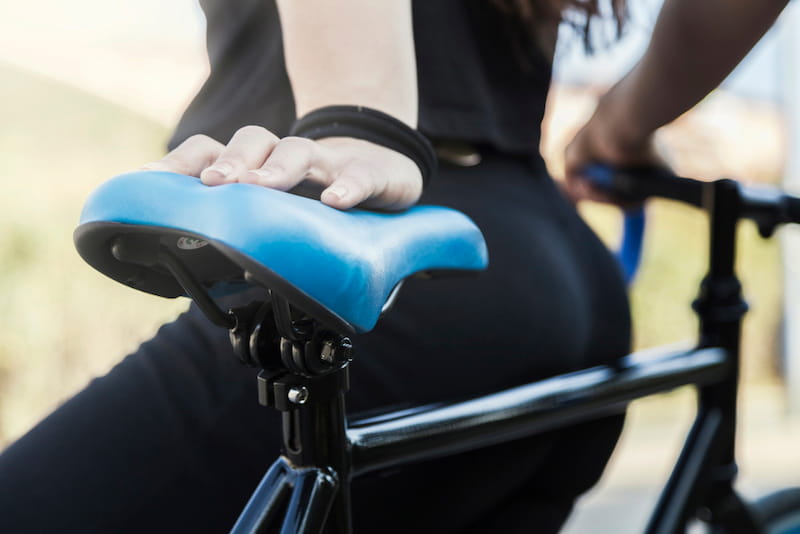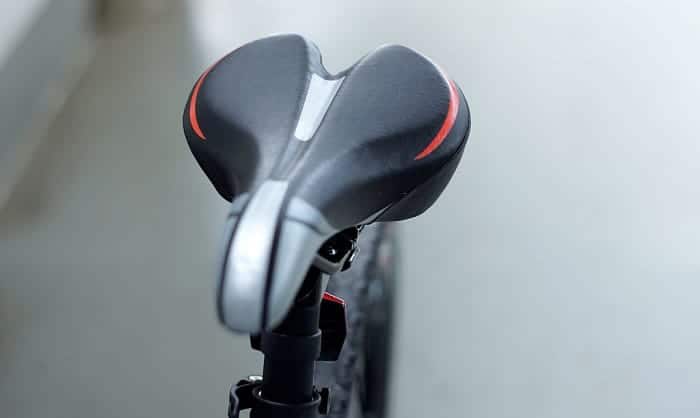Bicycle seats often cause discomfort. Many riders wonder why this happens.
Riding a bike should be fun and healthy. But uncomfortable seats can spoil the experience. It’s common to feel pain or numbness after a ride. This discomfort can come from various factors. The design of the seat, the type of bike, and how you sit all play a role.
Understanding these reasons can help you enjoy cycling more. In this blog, we will explore Why are Bicycle Seats So Uncomfortable. We will look at different causes and offer tips for a better ride. Stick around to find out how to make your next bike trip more comfortable.

Credit: bike.bikegremlin.com
Table of Contents
Bicycle Seat Discomfort
Bicycle seats, also known as saddles, often cause discomfort for many riders. This discomfort can deter people from enjoying cycling. Understanding why these seats are uncomfortable can help you find solutions.
Common Complaints
Many cyclists experience numbness after riding. Others complain about soreness in their lower back. Chafing is another frequent issue. These complaints can make cycling less enjoyable.
The Mystery Behind The Pain
One reason for discomfort is poor fit. Bicycle seats are not one-size-fits-all. Each rider has unique body measurements. Improper saddle height can lead to pain.
Another factor is the saddle design. Some saddles are too hard. Others are too soft. Both can cause issues. The saddle’s shape also matters. Narrow seats may not support your sit bones. Wide seats can cause chafing.
Lastly, riding position affects comfort. Leaning too far forward puts pressure on sensitive areas. An upright position can relieve some of this pressure.
Anatomy Of A Bicycle Seat
Bicycle seats play a crucial role in comfort and performance. Understanding the anatomy of a bicycle seat can help explain why they may feel uncomfortable. Let’s delve into the design elements and materials used.
Design Elements
The design of a bicycle seat is not just about looks. Several key elements influence comfort:
- Shape: The shape varies based on the type of cycling. Road bike saddles are narrow, while mountain bike saddles are wider.
- Padding: Some seats have minimal padding for better performance. Others have more padding for comfort during long rides.
- Nose: The front part of the seat, known as the nose, can impact how you sit and pedal.
- Cutouts: Some saddles feature cutouts or channels to reduce pressure on sensitive areas.
Materials Used
The materials used in bicycle seats significantly affect comfort:
| Material | Characteristics |
|---|---|
| Leather | Durable and molds to your shape over time, but heavy. |
| Gel | Soft and provides cushioning, but can wear out quickly. |
| Foam | Lightweight and firm, offering a balance between comfort and support. |
| Carbon Fiber | Extremely lightweight and stiff, ideal for performance but less forgiving. |
Each material has its pros and cons. Choosing the right saddle depends on your riding style and personal comfort preferences.
Impact Of Poor Fit
One of the main reasons bicycle seats feel uncomfortable is poor fit. A bicycle saddle that doesn’t fit properly can cause pain. It can also lead to long-term discomfort and potential injuries. Ensuring the right fit can make a significant difference in your cycling experience.
Saddle Height
Saddle height plays a crucial role in comfort. If the saddle is too high, it can strain your legs. It can also lead to lower back pain. On the other hand, if the saddle is too low, it can cause knee pain. Ensuring your saddle is at the right height is important. Your legs should be almost fully extended when the pedal is at the lowest point.
Saddle Angle
The angle of your saddle can affect your comfort as well. A saddle tilted too far forward can cause you to slide. This can put extra pressure on your hands and wrists. A saddle tilted too far back can strain your lower back. Aim for a level saddle to distribute your weight evenly. This helps maintain a comfortable and efficient riding position.

Credit: energym.io
Role Of Riding Style
The comfort of a bicycle seat can depend greatly on the rider’s style. Different riding styles place different demands on the body. This often leads to varying levels of comfort or discomfort. Understanding these styles can help explain why some seats feel unbearable.
Casual Riding
Casual riders often sit upright on their bikes. This position distributes weight more evenly across the seat. The wider, cushioned seats usually found on casual bikes are designed for this posture. Casual rides are generally shorter, reducing the chances of discomfort.
In casual riding, the focus is on comfort and leisure. Riders tend to go at a slower pace. They also take breaks more often. This means less pressure on sensitive areas. As a result, seats designed for casual riding tend to be more padded and wider.
Competitive Cycling
Competitive cyclists adopt a more aerodynamic position. This means leaning forward significantly. This posture shifts much of the rider’s weight to the narrow, front part of the seat. The seats for competitive cycling are often narrower and firmer.
In competitive cycling, the goal is speed and performance. Rides are longer and more intense. Cyclists stay in one position for extended periods. This can lead to more pressure on specific areas. Thus, seats are designed to minimize weight and reduce friction.
Competitive cyclists often wear padded shorts. These help to alleviate some of the discomfort. The combination of posture, seat design, and gear makes a big difference. But, even with these measures, some discomfort is almost inevitable.
Health Implications
Bicycle seats often feel uncomfortable to many riders. This discomfort can lead to various health issues. Understanding these health implications can help in choosing the right seat and improving your riding experience.
Pressure Points
One major cause of discomfort is pressure points. Bicycle seats can place excessive pressure on certain parts of the body. Common areas affected include the perineum and sit bones. This pressure can cause pain and numbness. Finding a seat that distributes weight evenly can help reduce pressure points. Padded shorts can also offer some relief.
Circulation Issues
Improper bicycle seats can also lead to circulation issues. Prolonged pressure on blood vessels can restrict blood flow. This can lead to numbness or tingling in the legs and feet. Ensuring that your seat is at the correct height can help improve circulation. Adjusting the tilt of the seat can also make a difference.
Gender Differences
Gender differences play a significant role in the comfort of bicycle seats. Men and women have different anatomies, leading to the need for distinct seat designs. Understanding these differences can help in choosing the right seat for a more comfortable ride.
Men’s Seats
Men’s bicycle seats are often narrower. This design reduces friction and pressure on the inner thighs. The seats also tend to have a longer nose. This aids in better weight distribution. Some men’s seats feature a cut-out or groove. This helps reduce pressure on sensitive areas.
Women’s Seats
Women’s bicycle seats are generally wider. This accommodates the wider pelvis and sit bones. The seats often have a shorter nose. This helps in reducing discomfort during long rides. Many women’s seats also include extra padding. This provides additional comfort and support. Some models may feature a central cut-out. This helps alleviate pressure on soft tissue areas.
Solutions For Comfort
Bicycle seats can often feel uncomfortable, especially on longer rides. This discomfort can discourage many from enjoying their biking experience. Luckily, there are practical solutions to enhance comfort. Here are some effective methods to make your bicycle seat more comfortable.
Choosing The Right Seat
The right seat can make a huge difference. Seats come in various shapes and sizes. A wider seat may provide more support. Gel or foam padding can add extra cushioning. Some seats have cutouts to relieve pressure on sensitive areas. Trying different seats can help you find the best one for your needs.
Proper Riding Position
Your riding position affects comfort. Ensure your bike is set up correctly. The seat should be level or slightly tilted. Adjust the seat height so your leg is almost straight at the bottom of the pedal stroke. Your handlebars should be at a comfortable height. A proper riding position distributes your weight evenly, reducing pressure on the seat.
A professional bike fitting can help you achieve the best riding position. A fitter can adjust your bike to match your body. This can significantly reduce discomfort and improve your ride.

Credit: www.magenenay.co.il
Innovations In Seat Design
Bicycle seats often get a bad reputation for being uncomfortable. Yet, modern innovations are changing this perception. Seat designs have evolved to offer better comfort and support. Let’s explore some of these innovations.
Ergonomic Designs
Ergonomic designs aim to fit the body’s natural shape. These seats reduce pressure on sensitive areas. They also provide better weight distribution. Riders experience less discomfort and pain. The focus is on enhancing overall comfort.
Adjustable Features
Adjustable features allow riders to customize their seats. You can change the height, angle, and position. This flexibility helps find the perfect fit. It caters to different body types and riding styles. Adjustable seats can improve your riding experience.
Expert Tips
Bicycle seats can be incredibly uncomfortable. But why is that? Many factors contribute to this discomfort. Fortunately, there are expert tips to help improve your riding experience. This section will cover Professional Fitting and Maintenance Tips to make your bike rides more enjoyable.
Professional Fitting
A professional fitting can make a huge difference. Here are some key points:
- Visit a bike shop for a custom fitting.
- Adjust the seat height to match your leg length.
- Ensure the saddle is level to reduce pressure points.
- Check the distance between the seat and handlebars.
A proper fitting reduces strain and discomfort. It’s worth the investment.
Maintenance Tips
Regular maintenance is essential. Here are some tips:
- Check the saddle for wear and tear.
- Lubricate the seat post to avoid rust.
- Tighten loose bolts to keep the seat stable.
- Replace the saddle if it feels worn out.
A well-maintained bike seat will be more comfortable. It also enhances safety.
Frequently Asked Questions
Why Do Bicycle Seats Cause Discomfort?
Bicycle seats cause discomfort due to pressure on soft tissues. Poor fit and improper posture can also contribute. Using padded shorts or a more ergonomic seat may help.
How Can I Make My Bike Seat More Comfortable?
To make your bike seat more comfortable, ensure proper seat height and angle. Consider padded shorts or a gel seat cover. Regularly adjust your riding position.
Are Wider Bicycle Seats More Comfortable?
Wider seats can be more comfortable for casual riders. However, they may cause chafing for long-distance cyclists. Choose a seat that fits your riding style.
Do Bike Seats Need Breaking In?
Yes, some bike seats need breaking in. Over time, the material molds to your body shape. This can improve comfort significantly.
Conclusion
Finding the right bicycle seat can make a big difference. Comfort varies for everyone. Take the time to try different seats. Adjust your bike for a better fit. Padded shorts can also help. Don’t let discomfort stop you from enjoying rides.
Regular breaks during long rides can ease pressure. Keep experimenting until you find what works best. Happy cycling!

